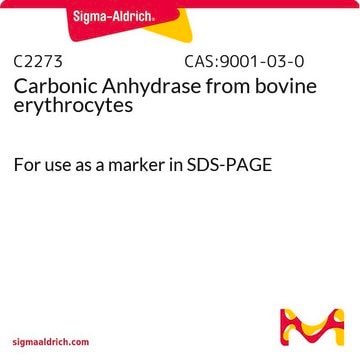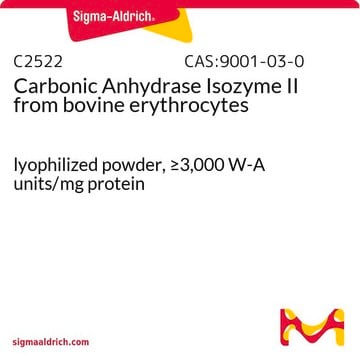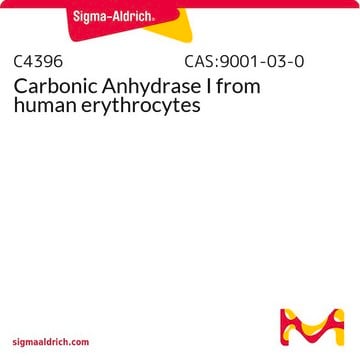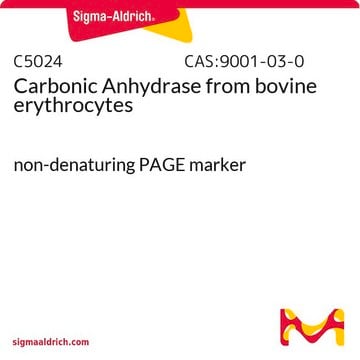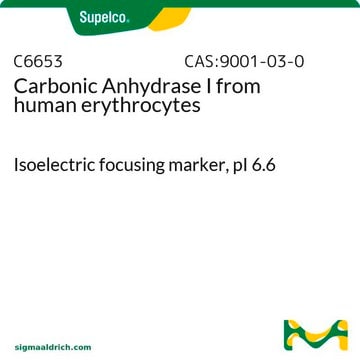C3640
Carbonic Anhydrase Isozyme II from bovine erythrocytes
lyophilized powder, ≥2,000 W-A units/mg protein
Synonym(s):
Carbonate Dehydratase, Carbonate Hydrolyase, Carbonic Anhydrase II
Sign Into View Organizational & Contract Pricing
All Photos(1)
About This Item
Recommended Products
form
lyophilized powder
Quality Level
specific activity
≥2,000 W-A units/mg protein
pI
~5.4
storage temp.
−20°C
Looking for similar products? Visit Product Comparison Guide
Application
Carbonic anhydrase from sigma has been used for the analysis of thermodynamic stability of the enzyme. The enzyme has also been used to generate CD4+ T cell lines specific for carbonic anhydrase during the study of autoimmune pancreatitis in rat.
Biochem/physiol Actions
Carbonic anhydrase is a zinc metalloenzyme that has a molecular weight of approximately 30,000 Da. The enzyme catalyzes the hydration of carbon dioxide to carbonic acid. It is involved in vital physiological and pathological processes such as pH and CO2 homeostasis, transport of bicarbonate and CO2, biosynthetic reactions, bone resorption, calcification, and tumorigenicity. Therefore, this enzyme is an important target for inhibitors with clinical applications in pathologies such as glaucoma, epilepsy and Parkinson′s disease.
Unit Definition
One Wilbur-Anderson (W-A) unit will cause the pH of a 0.02 M Trizma buffer to drop from 8.3 to 6.3 per min at 0 °C. (One W-A unit is essentially equivalent to one Roughton-Booth unit.)
inhibitor
Product No.
Description
Pricing
Signal Word
Danger
Hazard Statements
Precautionary Statements
Hazard Classifications
Resp. Sens. 1
Storage Class Code
11 - Combustible Solids
WGK
WGK 3
Flash Point(F)
Not applicable
Flash Point(C)
Not applicable
Personal Protective Equipment
dust mask type N95 (US), Eyeshields, Gloves
Choose from one of the most recent versions:
Already Own This Product?
Find documentation for the products that you have recently purchased in the Document Library.
Customers Also Viewed
Todd S Davidson et al.
The American journal of pathology, 166(3), 729-736 (2005-03-04)
Autoimmune pancreatitis (AIP), a recently defined disease of unknown etiology, is characterized by inflammatory infiltrates in the pancreas with conspicuous involvement of the ducts. The disease clinically manifests in humans as epigastric pain, weight loss, and jaundice. This report describes
Daumantas Matulis et al.
Biochemistry, 44(13), 5258-5266 (2005-03-30)
ThermoFluor (a miniaturized high-throughput protein stability assay) was used to analyze the linkage between protein thermal stability and ligand binding. Equilibrium binding ligands increase protein thermal stability by an amount proportional to the concentration and affinity of the ligand. Binding
Romualdo Talento et al.
Ultrastructural pathology, 37(1), 70-76 (2013-02-07)
Despite progress in the classification of renal cell carcinomas (RCC), a subset of these carcinomas remains unclassified (RCC-U). Patients with RCC-U usually present at a late stage and have a poor prognosis. Several studies have attempted to extract new classifications
Peter Burghout et al.
Journal of bacteriology, 195(7), 1573-1582 (2013-01-29)
Although carbon dioxide (CO2) is known to be essential for Streptococcus pneumoniae growth, it is poorly understood how this respiratory tract pathogen adapts to the large changes in environmental CO2 levels it encounters during transmission, host colonization, and disease. To
Laurie C Hofmann et al.
Journal of experimental botany, 64(4), 899-908 (2013-01-15)
The concentration of CO(2) in global surface ocean waters is increasing due to rising atmospheric CO(2) emissions, resulting in lower pH and a lower saturation state of carbonate ions. Such changes in seawater chemistry are expected to impact calcification in
Protocols
Objective: To standardize a procedure for the enzymatic assay of Carbonic Anhydrase (EC 4.2.1.1) for Wilbur-Anderson Units.
Our team of scientists has experience in all areas of research including Life Science, Material Science, Chemical Synthesis, Chromatography, Analytical and many others.
Contact Technical Service

